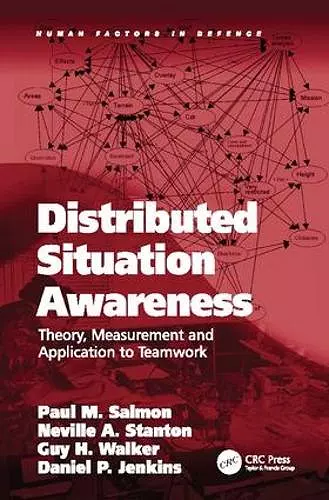Distributed Situation Awareness
Theory, Measurement and Application to Teamwork
Neville A Stanton author Paul M Salmon author Daniel P Jenkins author
Format:Paperback
Publisher:Taylor & Francis Ltd
Published:31st Mar '17
Currently unavailable, and unfortunately no date known when it will be back
This paperback is available in another edition too:
- Hardback£160.00(9780754670582)

Having an accurate understanding of what is going on is a key commodity for teams working within military systems. 'Situation awareness' (SA) is the term that is used within human factors circles to describe the level of awareness that operators have of the situation that they are engaged in; it focuses on how operators develop and maintain a sufficient understanding of 'what is going on' in order to achieve success in task performance. Over the past two decades, the construct has become a fundamental theme within the areas of system design and evaluation and has received considerable attention from the human factors research community. Despite this, there is still considerable debate over how SA operates in complex collaborative systems and how SA achievement and maintenance is best supported through system, procedure and interface design. This book focuses on the recently developed concept of distributed situation awareness, which takes a systems perspective on the concept and moves the focus on situation awareness out of the heads of individual operators and on to the overall joint cognitive system consisting of human and technological agents. Situation awareness is viewed as an emergent property of collaborative systems, something that resides in the interaction between elements of the system and not in the heads of individual operators working in that system. The first part of the book presents a comprehensive review and critique of existing SA theory and measurement approaches, following which a novel model for complex collaborative systems, the distributed SA model, and a new modelling procedure, the propositional network approach, are outlined and demonstrated. The next part focuses on real-world applications of the model and modelling procedure, and presents four case studies undertaken in the land warfare, multinational warfare and energy distribution domains. Each case study is described in terms of the domain in question, the methodology employed, and the findings derived in relation to situation awareness theory. The third and final part of the book then concentrates on theoretical development, and uses the academic literature and the findings from the case study applications to validate and extend the distributed SA model described at the beginning of the book. In closing, the utility of the distributed SA model and modeling procedure are outlined and a series of initial guidelines for supporting distributed SA through system design are articulated.
'Situation awareness is a term that has consumed both practitioners and the Human Factors community with no agreed approach despite volumes of publications on this topic. This well referenced book provides a comprehensive review of the nature of the concept and how it has been measured that is useful for both novices and researchers in this field. It does not duck controversy and criticises traditional individual- and team-based models of SA, proposing instead a distributed account of SA across agents and artefacts in order to more fully understand collaborative work activities. This approach emanates from the conceptualisation of distributed cognition in the mid 1990s and not only advances models of SA but also challenges us to consider how analyses of distributed SA should be carried out. Case studies are provided together with some solutions for carrying out such analyses. The book is refreshingly provocative, advances this area and has to be a recommended read for everybody interested in this topic...' John Patrick, Cardiff University, UK '"Situation awareness" (SA) has a central, almost mythical status within the pantheon of military concepts. In presenting their theory of distributed situation awareness (DSA), the authors make a radical departure from existing models.' Australian Defence Force Journal, September 2010 'Distributed Situation Awareness: Theory, Measurement and Application to Teamwork makes three broad contributions (literature reviews, case studies, and synthesis of findings), each of which makes a significant contribution to the understanding of SA. The book is well written, well referenced, with a logical structure and a consistent style (difficult to obtain in multi-author texts). Importantly, it ends with 18 very useful guidelines to assist designers of command and control systems to achieve distributed SA. Distributed Situation Awareness: Theory, Measurement and Application to Teamwork makes an excellent contribution to the understanding
ISBN: 9781138073852
Dimensions: unknown
Weight: 335g
266 pages